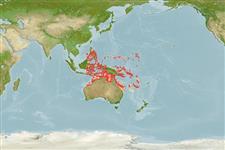>
Ovalentaria/misc (Various families in series Ovalentaria) >
Pomacentridae (Damselfishes) > Pomacentrinae
Etymology: Acanthochromis: Greek, akantha = thorn + Greek, chromis = a marine fish without identification, dealing with perch; cited by Plinius (Ref. 45335).
More on author: Bleeker.
Environment: milieu / climate zone / depth range / distribution range
Ekologi
laut berasosiasi dengan karang; nir-ruaya; kisaran kedalaman 1 - 65 m (Ref. 9710), usually 4 - 20 m (Ref. 90102). Tropical; 15°N - 26°S, 116°E - 169°E (Ref. 56301)
Western Pacific: Indonesia and the Philippines to northeastern Australia and Melanesia.
Size / Weight / umur
Maturity: Lm ? range ? - ? cm
Max length : 16.0 cm TL jantan/; (Ref. 129178)
deskripsi pendek
Kunci identifiaksi (pengenalan) | Morfologi | Morfometrik
Duri punggung (Keseluruhan (total)) : 17; duri punggung lunak (Keseluruhan (total)) : 14 - 16; Duri dubur: 2; Sirip dubur lunak: 14 - 16.
Adults inhabit inshore and offshore coral reefs (Ref. 9710). Also found in harbors, lagoons and outer reef slopes. The only pomacentrid species that lacks a pelagic larval stage. One of the very few marine fishes where fry are guarded by the parents (Ref. 9710, 48636). School as they grow and sub-adults are usually seen in small groups. Adults form pairs and are territorial when breeding (Ref. 48636). Monogamous (Ref. 52884). Oviparous (Ref. 205). Eggs are demersal and adhere to the substrate (Ref. 205). Males guard and aerate the eggs (Ref. 205).
Life cycle and mating behavior
Maturities | Reproduksi, perkembang biakan | Spawnings | Egg(s) | Fecundities | Larva
Oviparous, distinct pairing during breeding (Ref. 205). Monogamous mating is observed as both obligate and genetic (Ref. 52884). Eggs are demersal and adhere to the substrate (Ref. 205). Males guard and aerate the eggs (Ref. 205). Does not have a juvenile bisexual phase and all males have the typical testicular morphology of gonochores (Ref. 103751).
Allen, G.R., 1991. Damselfishes of the world. Mergus Publishers, Melle, Germany. 271 p. (Ref. 7247)
Status IUCN Red List (Ref. 130435)
ancaman kepada manusia
Harmless
penggunaan manusia
Alat, peralatan
laporan khas
muat turun XML
Sumber internet
Estimates based on models
Preferred temperature (Ref.
123201): 25.1 - 28.9, mean 27.8 °C (based on 458 cells).
Phylogenetic diversity index (Ref.
82804): PD
50 = 1.0000 [Uniqueness, from 0.5 = low to 2.0 = high].
Bayesian length-weight: a=0.03236 (0.01926 - 0.05438), b=3.05 (2.90 - 3.20), in cm total length, based on LWR estimates for this species & (Sub)family-body (Ref.
93245).
Trophic level (Ref.
69278): 2.7 ±0.30 se; based on food items.
Daya lenting (Ref.
120179): Tinggi, Waktu penggandaan populasi minimum kurang dari 15 bulan (Preliminary K or Fecundity.).
Fishing Vulnerability (Ref.
59153): Low vulnerability (13 of 100).
Nutrients (Ref.
124155): Calcium = 112 [57, 167] mg/100g; Iron = 0.861 [0.520, 1.422] mg/100g; Protein = 18.3 [17.1, 19.4] %; Omega3 = 0.121 [0.074, 0.195] g/100g; Selenium = 36.9 [20.2, 68.6] μg/100g; VitaminA = 50.9 [13.7, 180.6] μg/100g; Zinc = 1.67 [1.14, 2.38] mg/100g (wet weight);
